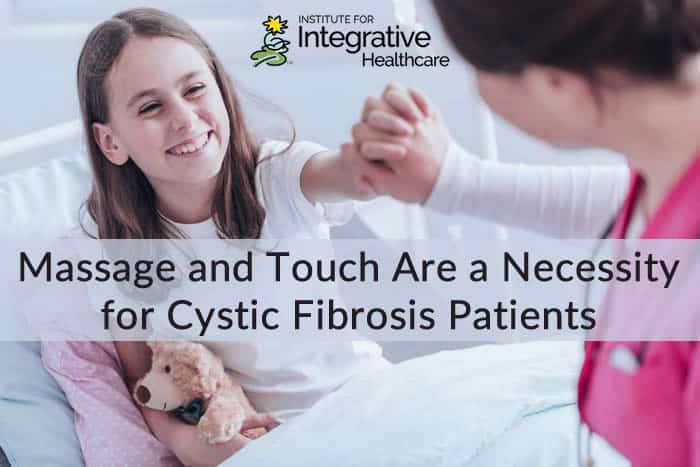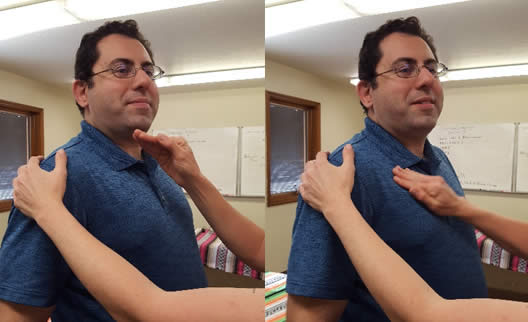

About Cystic Fibrosis
Cystic fibrosis (CF) is a genetic disorder resulting in excessive excretion from exocrine glands.
Viscous, thick fluid is produced within any of these regions:
- digestive
- integumentary
- reproductive
- and respiratory system pathways. (1)
This fluid formation results in the body’s inability to move chloride, a component of salt, in cellular fluid osmosis. Fluids become a thicker, sticky secretion which occludes pathways within systems.
The respiratory system is especially sensitive to the thick secretion buildup as this interferes with the ability to ventilate air, thus making breathing difficult. The trapped mucous can harbor infections, inflammation and lead to respiratory complication.
The underutilization of chloride stems from a recessive Transmembrane Conductance Regulatory (CFTR) gene which results when the recessive gene is passed from both parents. (2)
There are approximately 1,000 new cases of CF diagnosed each year with the vast majority diagnosed by age 2. More than 30,000 people are living with CF annually. The 2017 Cystic Fibrosis Foundation Patient Registry estimates patients born between 2013-2017 places life expectancy in the mid-40s, a significant increase in recent decades. (3)
Common Signs and Symptoms of CF
- Salt laden skin
- Persistent productive cough
- Frequent bouts of pneumonia, bronchitis, similar lung conditions
- Shortness of breath
- Wheezing breath
- Bowel challenges
- Poor weight gain efforts
Typical Treatments for CF Patients
On a weekly basis, often several times a week, CF patients complete a combination of varying therapies to alleviate congestion and fluid retention within exocrine glands. Airway clearance helps loosen and release clogged, thick mucous accumulating within lung airways. Inhaled medications coupled with a nebulizer can include antibiotics to fend off infectious agents. Pancreatic enzyme and multivitamin supplements may improve nutrient absorption with each meal. CFTR modulating therapies are designed to correct the malfunctioning CFTR gene. There can be numerous mutations of this gene; finding a medication can take time to match one’s specific gene mutation.
Additionally, a fitness plan to include cardiovascular exercises, thereby encouraging healthier breathing, can play a significant role in CF treatment care.
These routines can include:
- walking
- running
- treadmill or elliptical machines
- and meditative breathing exercises.
Pranayama exercises from yoga will augment these plans.
5 Approved Drugs for Cystic Fibrosis
There are several drugs approved by the FDA for CF patient treatment. (4)
- Ivacaftor (Kalydeco): common side effects include nausea, stomach pain, vision problems, cold/flu symptoms, hypoglycemia and liver challenges.
- Lumacaftor (Orkambi): common side effects include breathing difficulties, nausea, skin rash, and chest discomfort.
- Tezacaftor (Symdeko): common side effects include headache, dizziness, and running nose.
- Aztreonam (Cayston): common side effects include fever, chest discomfort, cough, and dyspnea.
- Tobramycin (TOBI): common side effects include changes in voice, cold like symptoms, and fever.
Support Available
There are hospital divisions specific to CF care in 10 states nationwide:
- University of Alabama, Birmingham, AL
- University of California, San Francisco, CA
- National Jewish Health, Denver, CO
- Emory University, Atlanta, GA
- University of Iowa, Iowa City, IA
- Dartmouth University, Hanover, NH
- University of North Carolina, Chapel Hill, NC
- Case Western Reserve University, Cleveland, OH
- Children’s Hospital Medical Center, Cincinnati, OH
- University of Pittsburgh School of Medicine, Pittsburgh, PA
- University of Washington School of Medicine, Seattle, WA
Massage Considerations for CF Patients
Keeping your massage space hygienic is especially important for CF patients.
Remember to thoroughly clean and sanitize your massage room space before seeing a CF patient. Certainly, cleaning is already occurring, yet sanitizing may be necessary as well. To clarify, sanitation involves means to significantly reduce the number of microorganisms and pathogens in a region. (5) Wash items first with hot water and soap, then rinse thoroughly. After submersion in a disinfectant solution, rinse well with clean water and wipe dry with a clean towel.
A study from Alfred Hospital, La Trobe University in Victoria, Australia highlights the benefits of massage therapy for CF patients. Published in the Journal of Cystic Fibrosis, this study indicated a significant reduction in pain, and that massage made breathing easier for patients, both in the acute exacerbation group and clinically stable group.
Since breathing can become difficult, focusing efforts to ease myofascial tension upon the rib cage can help greatly. Muscles attaching to the ribs include the Rectus Abdominis, Oblique muscles, Scalenes, Intercostals, Serratus anterior & posterior fibers, Quadratus Lumborum and Erector Spinae muscles. A session to reduce tension in these muscles will aid in breathing.
Usage of vibrational tools may be useful to help clear congestion within the air pathways and exocrine ducts. Gentle vibration tools which oscillate at less than 1,000 movements per minute is sufficient to clear away congestion and viscous fluid within ten minutes. Ensure there is a waste receptacle available to hold phlegm coughed up by the patient. Use a Biohazard bag to store and eliminate this waste properly.
Conclusion
Vigorous styles of massage, including sports massage and adding vibration and percussion to the session will be beneficial to the CF patient. Engaging movement of the upper body with stretches, rocking, jostling, vibration and tapotement techniques can encourage movement of bound congestion and fluids. Incorporate these techniques into a classic session to maximize benefits of massage.
Tapotement with a cupped hand as seen in the images below, can be a great tool to help loosen and eliminate congestion from the chest cavity and airways.

Testimonial on Massage
Debra Hooper, massage therapist in Payson, AZ, shares experience with her daughter with cystic fibrosis. Debra shares that “all massage is great for CF, but especially cupping hand tapotement around the entire rib cage and lung area. I utilize lung acupoints.”
Debra continues: “I choose to diffuse therapeutic grade essential oil in distilled water and apply topical treatments of essential oils for comfort and relief. Stretching is great as well as yoga. I feel that touch and holistic therapy is a necessity in care and treatment for all and absolutely in my daughter’s case.”
Regarding signs and symptoms, Debra shares “her biggest challenge is digestion and nutritional absorption. She also does not love her medical treatments as they are long and daunting to her.” (6)











